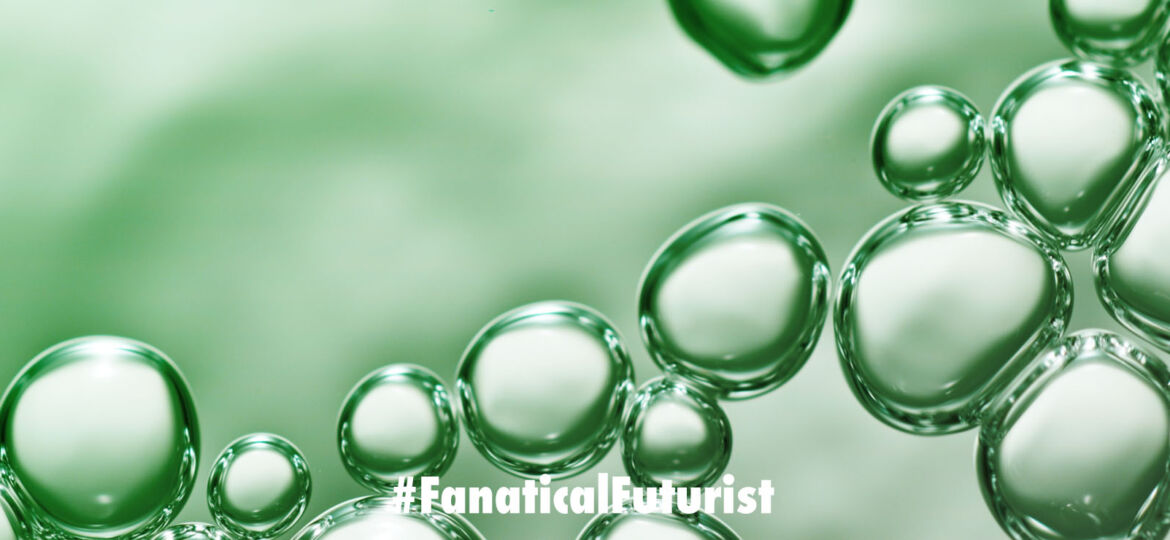
WHY THIS MATTERS IN BRIEF
Hydrogen has ten times the energy storage capacity of Lithium Ion batteries and is zero emission, but the technology needs to scale up to be cost competitive.
 Love the Exponential Future? Join our XPotential Community, future proof yourself with courses from XPotential University, connect, watch a keynote, or browse my blog.
Love the Exponential Future? Join our XPotential Community, future proof yourself with courses from XPotential University, connect, watch a keynote, or browse my blog.
Over the past year green hydrogen, as a climate friendly zero-emission energy source, has been increasingly in the news – whether it’s Airbus showing off its latest hydrogen powered e-Zero aircraft, or other companies showing off their latest hydrogen powered drones, flying taxis, semi-trucks, supercars, and superyachts, or Californian utilities announcing plans to pipe it through the conventional gas grid.
As the world tries to wean itself off of fossil fuels hydrogen, as well as more traditional renewable energy technologies such as solar, wind, and tidal, are gaining in popularity with over 1 Trillion watts of renewables now installed around the world. And now, Air Products and Chemicals, the US industrial gas giant, have announced that they’re going to build a green hydrogen plant in Saudi Arabia that’s powered by 4 gigawatts of wind and solar power which makes it the largest such project announced so far.
The $5 billion plant will be jointly owned by Air Products, Saudi Arabia’s ACWA Power and Neom, a new mega-city planned near Saudi Arabia’s borders with Egypt and Jordan.
The completed facility will produce 650 tons of green hydrogen a day which would be enough to run around 20,000 hydrogen-fuelled buses, Air Products said. The fuel will be shipped as ammonia, which itself is being lined up as a jet fuel to power the first generation of hypersonic aircraft, to end markets globally then converted back to hydrogen. Ammonia production is expected to start in 2025.

The site of the new megaplant
Pennsylvania-based Air Products claims to be the world’s largest producer of hydrogen and a leader in the liquefied natural gas field technology. The company trades on the New York Stock Exchange with a market value of nearly $60 billion.
The project would also be a big step forward for Saudi Arabia’s ambition for Neom, their $500 Billion smart city which I wrote about recently, to become an important global center for renewable energy and green hydrogen. The country is establishing Neom as a special economic zone, with an ambition to host 1 million people from around the world.
“This is a pivotal moment for the development of Neom and a key element in Saudi Vision 2030 contributing to the Kingdom’s clean energy and circular carbon economy strategy,” Neom CEO Nadhmi Al Nasr said in a statement.
Speaking to analysts on a conference call on Tuesday, Air Products CEO Seifi Ghasemi said the company is confident the project will be viable without subsidies given the accelerating global race for low-carbon transport fuels. Any government support would be “icing on the cake.”
“There are 260 million commercial vehicles in the world. If 1 percent converts to hydrogen, you end up with huge numbers that would require 50 plants like this,” Ghasemi said. “We’ve been working on this for four years, and our strategy was to be the first to build a mega-scale plant.”
In addition to the $5 billion plant, the project will require $2 billion of new distribution infrastructure, to be owned by Air Products.
Asked whether the project economics would stand up to current hydrogen prices, Ghasemi said yes, before correcting himself and saying that green hydrogen will garner a premium.
Green hydrogen is currently uncompetitive with its gray cousin, which is produced using natural gas. Competitively priced green hydrogen will require low power prices and high electrolyzer utilization rates. Air Products believes it can secure both with a large pool of takers and access to Saudi Arabia’s vast renewable energy resources.
ACWA Power has delivered a series of major solar projects in recent years and has previously achieved record-low solar prices in the region, and German’s Thyssenkrupp will supply the electrolyzers which will be used to convert water into Hydrogen. Last month the also company revealed its electrolyzer manufacturing capacity had reached 1 gigawatt, with the option to ramp up further. Norwegian firm Nel and the UK’s ITM Power are also developing electrolyzer gigafactories.
A number of major oil and industrial players are rapidly accelerating their investments into green hydrogen. BP is studying the feasibility of an ammonia plant in Australia, powered by 1.5 gigawatts of wind and solar, previously thought to be the largest such plan.
“Hydrogen is not niche anymore,” said Christoph Noeres, head of energy storage and hydrogen at Thyssenkrupp. “It will enable the sector coupling [required] to reach the Paris Agreement’s climate goals. Hydrogen has been identified to be the key element for sustainable fuels and chemicals and can reduce or avoid CO2 in sectors where electrification is not possible.”
















